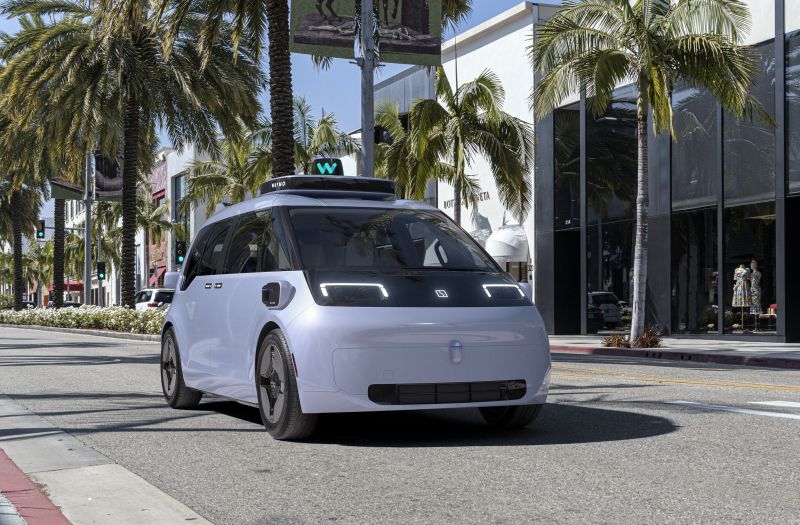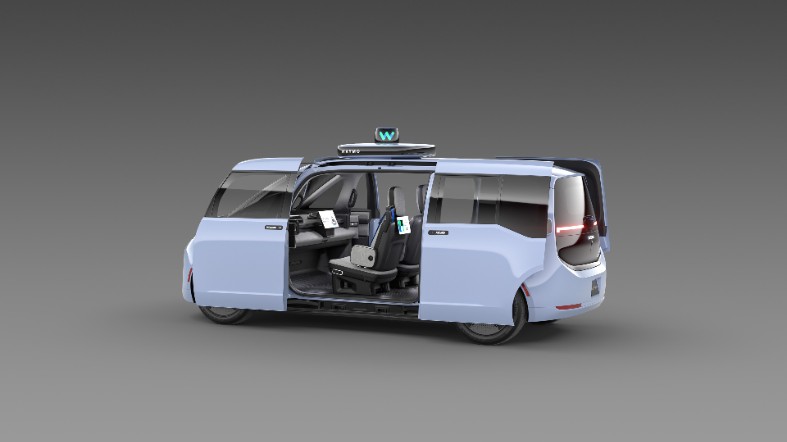Waymo Reveals its New Robotaxi Built by New Premium Electric Vehicle Brand Zeekr
【Summary】Alphabet's autonomous driving unit Waymo, which spun out of Google's self-driving car project, unveiled its latest autonomous passenger vehicle at the Los Angeles Auto Show this week. The company’s next generation electric robotaxi is being built by Chinese premium electric automaker Zeekr and represents the future of mobility for Waymo customers.

Alphabet's autonomous driving unit Waymo unveiled its latest autonomous passenger vehicle at the Los Angeles Auto Show this week. The company's next generation electric robotaxi is being built by Chinese premium electric automaker Zeekr and represents the future of mobility for Waymo customers.
Zeekr was launched in 2021 by automaker Geely as a standalone premium electric brand to compete with Tesla, NIO, Xpeng Inc and others in China's growing EV market. Geely is also the parent company of Volvo Cars. Geely and Volvo Cars also jointly operate the electric performance brand Polestar.
The futuristic electric Waymo robotaxi is based on Zeekr's M-Vision concept, which will enter volume production in 2024. Its built on the automaker's new Sustainable Experience Architecture ("SEA") platform.
The SEA platform is designed to support a wide variety of uses, including robotaxis, multi-purpose vehicles and logistics vehicles. The flexible architecture allows customers like Waymo to add its own autonomous driving technology to the vehicle.
All SEA-M-based Zeekr passenger vehicles will meet global five-star safety standards and will be a top safety pick requirements from the Insurance Institute for Highway Safety (IIHS).
"The unveiling of Zeekr's SEA-M has shown the brand's technological strengths and potential," said Zeekr CEO Andy AN. "The affirmation of partners for the SEA-M has also reflected Zeekr's ability to customize development according to the needs of each user,"
Waymo said the multi-passenger Zeekr commercial robotaxi was designed to prioritize the comfort, convenience, and preferences of Waymo One ride-hailing customers.
The Waymo robotaxi features a long wheelbase, power sliding doors and a flat floor with a low step-in height, which makes its easier for passengers to enter and exit the vehicle. It also offers generous headroom and fully adjustable seats. Other features include infotainment screens for front and rear passengers and built in chargers for cell phones and other electronic devices.

Waymo's robotaxi feature power sliding doors for easier entry and exit.
Wamyo announced in February that Zeekr was selected to build vehicles for its autonomous ride-hailing service called Waymo One.
The ZEEKR M-Vision on which Waymo's robotaxi is based was jointly designed by Zeekr's R&D facility, named the China Europe Vehicle Technology Center ("CEVT") in Gothenburg, Sweden, with additional support from an R&D team from China.
Waymo said it will integrate its full stack autonomous driving technology stack called the "Waymo Driver" into the commercial version of the all-electric Zeekr vehicle. The Zeekr robotaxi was designed in Sweden specifically for autonomous ride-hailing. The all-electric robotaxi will eventually replace the gas-powered models in the Waymo One fleet.
Waymo is also using hybrid Chrysler Pacifica minivans and all-electric Jaguar I-Pace SUVs in its robotaxi fleet.
The Zeekr robotaxi will have two designs, one without a steering wheel and one with conventional driver controls. Waymo plans to deploy the passenger-focused, fully autonomous Zeekr robotaxi on U.S. roads over the next several years as part of the Waymo One fleet.
The Zeekr robotaxi is also built to handle the rigors of daily commercial use. Zeekr said the M-Vision features an extended service life of 5 years/500,000 kilometers. The EV is designed to run for 16 hours of non-stop driving per day.
Waymo is widely considered to be the industry leader in the development and deployment of autonomous driving technology. The company has extensive experience as Waymo spun out of Google's self-driving car project, which began its work on self-driving vehicles in 2009.
To date, Waymo's fleet of self-driving vehicles has traveled over 25 million miles on public roads as the company refines its driverless technology. In preparation for a commercial launch of Waymo One ride-hailing service in San Francisco, the company's fleet traveled 2.7 million miles on the city's streets alone last year mapping and collecting valuable data to improve its Waymo Driver autonomous driving platform.
The experience of riding in one of Waymo's autonomous vehicles is just like taking a trip with Uber. Riders summon one of Waymo's autonomous vehicles using the Waymo One app. Once the vehicle arrives and the passengers are seated and bucked up, they simply press the trip start button on a touchscreen display to begin their journey.
A monitor in the backseat of each vehicle also shows the vehicle's perception systems in real time and riders get an expanded look at what the self-driving vehicle "sees" as it navigates autonomously in the city using cameras, radar and lidar.
Riders also have a pull over button in case a passenger needs to cut their trip short. If a rider hits the button the vehicle will pull over in a safe location and let them out.
Geely raised $500 million in the first-ever external funding round for its new EV brand Zeekr in Oct 2021.
Zeekr's first model was the "001", a compact, battery powered wagon. Earlier this month, Zeekr officially launched its second model, a sleek passenger van named the "009".
Zeekr's new electric multi-passenger van (MPV) will be the world's first vehicle powered by an advanced battery developed by battery maker Contemporary Amperex Technology Co Ltd. (CATL) called the "Qilin" that was unveiled over the summer.
CATL is the world's biggest supplier of batteries to the auto industry and the largest lithium-ion battery producer in China. The company's automotive customers include Tesla.
The more energy-dense, cell-to-pack Qilin battery allows an electric vehicle to travel up to 1,000 km (621 miles) on a single charge, according to CATL. The impressive range of the Qilin battery can be a game changer for the auto industry and lead to the widespread global adoption of electric vehicles.
-


Ford is Testing a New Robotic Charging Station to Assist Drivers of EVs With Disabilities
-


Ford Raises the Prices of the F-150 Lightning Electric Pickup Due to Rising Raw Material Costs
-


The BMW 7-Series to Feature HD Live Maps From HERE Technologies for Hands-Free Highway Driving in North America at Speeds up to 80 MPH
-


AutoX to Use the 'Eyeonic Vision Sensor' from California-based SiLC Technologies for its Robotaxi Fleet in China
-


LG Develops ‘Invisible’ Speaker Sound Technology That Could Revolutionize In-Vehicle Audio
-


Researchers at South Korea’s Chung-Ang University Develop a ‘Meta-Reinforcement’ Machine Learning Algorithm for Traffic Lights to Improve Vehicle Throughput
-


Zeekr’s New 009 Electric Passenger Van is the World’s First EV to Feature CATL’s Advanced ‘Qilin’ Battery With a Range of 510 Miles
-


Redwood Materials is Building an Electric Vehicle Battery Recycling Facility in South Carolina
- Lucid Launches New Performance Brand ‘Sapphire’ with a 1,200 Horsepower, Tri-Motor Version of the Lucid Air Sedan
- Audi Rebrands its Premium Car Rental Service to ‘Audi on demand’
- The BMW 7-Series to Feature HD Live Maps From HERE Technologies for Hands-Free Highway Driving in North America at Speeds up to 80 MPH
- GM to Invest $81 Million to Hand-Build Cadillac Celestiq in Michigan
- Volvo’s Parent Company Geely Launches a New Outdoor Lifestyle EV Brand Named 'RADAR'
- Waymo Reveals its New Robotaxi Built by New Premium Electric Vehicle Brand Zeekr
- Ford Motor Co Selects its Plant in Spain to Build 'Breakthrough' EVs for the European Market on a Next-Gen Architecture
- Waymo To Partner With Uber Freight on Autonomous Logistics for the Trucking Industry
- Tesla Believes Its Dojo AI System Will Help It Win the Self-Driving Car Race
- BMW i Ventures Invests in Vendia, a Next-Gen Blockchain Company Helping Businesses to Securely Share Data With Third Parties











 About Us
About Us Contact Us
Contact Us Careers
Careers